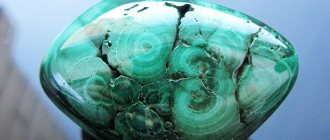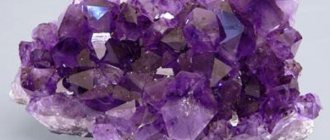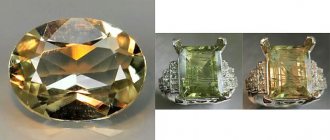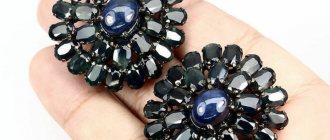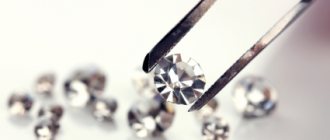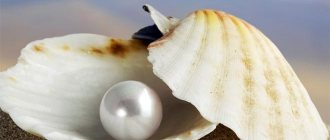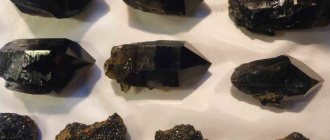What will help you recognize a fake?
A fake is different from a precious metal, but often the difference is difficult to detect even for a jeweler. But you can determine which jewelry was purchased in a store yourself at home. The following will help you recognize fake gold:
- Vinegar.
- Pencil to stop bleeding.
- Iodine.
- Paper.
- Magnet.
- Other gold jewelry.
Testing gold with vinegar
Expertise from a jeweler is considered the most reliable. A specialist will help establish the authenticity of the product and issue a conclusion.
So, several ways to distinguish real gold from fake.
Acetic acid oxidizes metals, but it will not have any effect on gold. You can put a piece of jewelry in a glass of vinegar and water and see what happens to it. Gold will not make the water cloudy, its color will remain the same, but if a fake was immersed in a glass of acid, the water will become dark, cloudy, and the jewelry will darken.
To be fair, it is worth noting that pure gold is rare. Jewelry is made from alloys. This happens because gold is a very ductile metal.
Iodine will leave a mark on poor-quality jewelry; it can be dark or light yellow. Counterfeiting gold has long become widespread, so the first rule for a buyer is to choose a store that sells precious items.
Testing a gold ring with iodine
The gold-like metal can be identified using a pencil to stop bleeding. You should run a lapis pencil over the decoration, and if a noticeable mark remains, then it is a fake.
Two different decorations can be drawn across a piece of paper. One must be selected for testing, and the quality of the other cannot be doubted. If the stripes remaining on the paper are the same, then the product being tested is of high quality.
To check you will need two gold items. They are visually compared with each other, using a magnifying glass to determine the quality of the decoration.
Selection criteria and recommendations for purchasing
The first thing you should know when going to a store to buy gold jewelry is that it must be reputable and certified. It is highly not recommended to buy such products in small shops, kiosks, and especially on the Internet on dubious sites.
You don’t need to trust your intuition and especially chase the cheapest. A suspiciously low price for jewelry supposedly made of gold should be the first signal that it is a fake. All high-quality jewelry made of precious metal must be hallmarked, even if it was made to order.
If you know a jeweler, it is better to ask him to check the authenticity of the selected product. You can use a paid gold determination service. Now they are provided in any specialized stores, workshops and even pawn shops.
other methods
How to distinguish gold from fake? There are several answers to this question; the following will help determine the quality of the product:
- sample on decoration;
- “tooth test”;
- light adaptation.
The first step is to carefully examine the sample on the jewelry. If it is fuzzy, cloudy, and the numbers are poorly visible, it is better to put this decoration aside.
In some cases, the sample is placed on a lock or on a mount. Therefore, it is worth carefully examining the decoration; perhaps there is another sample somewhere.
In films about the Wild West, the question of how to distinguish valuable metal from a fake was not relevant. The coins were checked “by the tooth”. Since gold is a ductile metal, it will leave a small dent on its surface. But if, after such a check, the jewelry turns black at the “bite” site, then this indicates its low quality.
The light and shadow test is the simplest and can be easily done in the store. The precious metal shines equally in the shade and in the sun. If under the rays of the sun the jewel sparkled with new colors, but in the shadow it looked faded and unattractive, then it is a fake.
How to distinguish copper from gold? Very simple. Copper turns green when in contact with water, and it is also more durable and less ductile. It is present as an alloy in precious jewelry, this should not be forgotten.
Gold is not attracted to a magnet.
Checking a gold ring with a magnet
Gold: what is it?
Rare earth precious metal yellow in color. Does not oxidize and does not lose its properties over time. Due to its plasticity and softness, it can be easily processed using both cold and melting methods. Its softness does not allow it to be used as jewelry in its pure form.
To make jewelry, harder metals are added to give it hardness, such as silver or copper. All so-called gold jewelry are alloys.
Any jeweler is well aware of the ratio of gold in the alloy. Some of them, especially unburdened by conscience, use this knowledge for their own selfish purposes. But there are some rules that can help determine whether the gold you are being offered is real or a cheap fake.
Buy gold only in reputable jewelry stores operated by jewelry factories, but not in boutiques and small stalls. The cost will, of course, be more expensive, but there will be less risk of buying a fake.
A real ingot must be marked with data about the sample. A careful study of the tag will tell you about the manufacturer, the price per gram and for the entire jewelry as a whole, weight, sample. There must be an OTK stamp. The sample indicates the content of pure gold in the jewelry.
The most popular are 585 and 750. This means that they contain 58.5% and 75% pure gold, respectively. When the sample is found, you should carefully examine the clasp of the bracelet or earring. If there are scratches on them, then you should not take this product.
The reason here is the following. In bracelets, chains and earrings, the sample is placed on the clasps. And suppliers only send locks for inspection and, after inspection, calmly place them on gold-plated fakes.
Finally, you should find the logo or imprint of the manufacturing company on the reverse side of the jewelry. The method described now relates to the visual assessment of gold.
But this is also not an indicator of reliability, since in Turkey, for example, they can give you any test before your eyes. Yes, and not only there. A fuzzy, blurry sample is the first sign of a fake; such gold should not be taken. The second detail that you should pay attention to is the inside of the product, which should be perfectly mirror-like, without any irregularities or roughness.
How to recognize gilding?
Experts know how to distinguish fake from real gold, but sometimes they make mistakes. Cunning manufacturers do not send a whole product for inspection, but only a part of it, for example, the links of a chain or the lock of a bracelet.
The expert tests the product, and the manufacturer embeds a lock into a piece of low-quality jewelry.
Most often, brass and gold plated are passed off as precious metals. How to distinguish gold from brass? For this you will need:
- ceramic tableware;
- gold product.
The ceramic product must be uncoated. The decoration is passed over it, and if a dark mark remains on the surface of the dish, it means it is a fake. The gold will leave a streak of yellow.
If you need to recognize gilding, you can scratch it behind the film of precious metal: a black stripe will appear, which indicates the low quality of the jewelry.
How to distinguish good quality gold from fake? Temperature will help with this. You need to heat the decoration over the stove. High temperature will not affect the noble metal in any way, but the fake will change: dark stains will appear on its surface.
You can throw the jewelry on a smooth, flat surface. Noble metal will make a characteristic sound, but this method of testing is not suitable for chains and bracelets, as well as long earrings.
Methods of applying gold plating to jewelry
Very often, vintage and antique jewelry is marked: Gold plated, Gold filled, Gold soldered . People ignorant in this area make a colossal mistake when all these concepts are translated as “gilding.” In fact, there is a big difference in these methods of gilding jewelry.
Gold Plated is the most common method of gilding. GP is an electroplating coating that deposits a thin layer of gold on the product, not exceeding a few microns in thickness. There is no single standard regulating the percentage of gold that should be included in jewelry with the GP mark. If the manufacturer is conscientious, he will apply several layers of gold plating; otherwise, the jewelry will be of the lowest quality. Gold Plated products cannot be worn on the body, as a chemical reaction is possible when combined with sweat, which will spoil the appearance of the fittings.
Gold filled is a more expensive coating that is used to create jewelry that falls into the fine jewelry category. The golden layer is created by rolling. Rapid heating of the precious filler together with a base metal substrate in an airless space at a maximum temperature of 900 degrees and compression by hydraulic pressure makes it possible to create a gold coating up to 8-10 microns thick. All GF jewelry has special designations that allow you to understand the percentage of gold in the alloy. For example, 14K/20 GF. The abbreviation GF stands for gilding method. 14K is the designation of gold that was used in the manufacturing process of the product (in this case we are talking about 14 karat gold). “20” - indicates the percentage of the alloy to the total weight of the jewelry (1/20 share, that is, 5%).
Gold soldered - tinning of gold in tin-lead solder. In this case, the gold plating layer reaches 15-17 microns. Due to this, the thickness of the gold plating is reduced, which affects the high cost of making jewelry. This method involves the use of gold of any standard.
What jewelry should you not buy?
If there is a decoration on the surface:
- Scuffs.
- Roughness.
- Chips.
- Fuzzy sample.
- The product has an uneven color.
Jewelry has a characteristic cold shine. They should be even and smooth, the color of the product should be the same with tints of shade. No dark stains or stripes are allowed.
The higher the standard, the better the quality of the product, but it is impossible to find pure gold in the store. The most popular hallmarks are 585 and 750, these jewelry are of high quality, but the precious metal is mixed with silver, copper and other metals that have no value. All in order to increase the durability of the decoration.
According to experts, gold from Turkey most often turns out to be fake and of low quality. The Turks can test any test for fake gold on the street. Therefore, you should be careful when purchasing gold products and avoid dubious sellers and points of sale. An unscrupulous merchant will never tell the buyer how to recognize a piece of jewelry. He will simply praise his product.
What can I do to prevent the gold plating from peeling off?
Jewelry made from silver or base metals with gilding, as a rule, is indistinguishable in appearance from jewelry made from solid gold. But the attractive appearance is maintained only until the thin layer of gilding is erased, revealing a less valuable base.
Therefore, jewelers recommend not using gold-plated items for everyday wear. Be sure to remove them before showering, exercising, or doing housework. Such products must be cleaned very carefully so as not to damage the top layer of gold.
Checking with improvised means
Of course, checking using the above methods does not always give a 100% guarantee that what you are looking at is not a fake. Perhaps you did the experiment incorrectly (you didn’t see the sample or the top covering of the table turned out to be too soft) or you still doubt the quality of the gold product.
Then the following available means will come to the rescue: iodine, vinegar and ordinary black bread. Read on to learn how to check.
Iodine
To check authenticity using iodine you need:
- Place 1 drop of iodine on the jewelry and wait 5 minutes.
- Wipe the iodine with a tissue or rinse with water. If the jewelry has changed color and darkened, it is a fake. When darkening, the color of the product changes to gray or black with a greenish tint.
Place one drop of iodine on the jewelry and wait five minutes
Vinegar
Another easy way to check authenticity is to use regular table vinegar:
- To do this, you need to pour a small amount of vinegar into a ceramic or plastic bowl (never an iron one).
- Place the decoration in it and leave for 5-7 minutes.
- Gold will not change its appearance in any way , but the fake will darken.
Nitric acid
Another method of chemically testing gold for authenticity is the reaction to nitric acid:
- To conduct the experiment, place the jewelry being tested in a deep metal bowl and drop 1 drop of nitric acid onto it.
- If the product does not change color to green or milky , it means it is made of gold.
To conduct the experiment, place the jewelry being tested in a deep metal bowl and drop just one drop of nitric acid onto it.
Scratch with a needle
You can also check the authenticity of a gold item using a regular needle. To do this, you need to forcefully scrape the jewelry being tested with a needle. Nothing will happen to real gold. But the gilding will come off easily.
Contact with gold
Every person has a gold item, the authenticity of which he has no doubt:
- In order to carry out the test, you need to: draw a line with real gold on a hard surface.
- Carry out a similar action on the same surface and with the object you doubt.
- There should be no differences between the lines.
You can purchase a special jewelry set with samples of different metals. This way you will determine not only the authenticity of the gold, but also its quality.
Magnet
Every person knows that pure gold is in no way magnetic:
- Apply the product being tested to a magnet and see what comes out of it all.
- If a product is even slightly attracted to a magnet, it is an alloy of metals. Copper can most often be passed off as gold. However, counterfeit gold items often involve metals such as aluminum, copper and tin. They also do not respond to magnetic testing, but are lighter in weight than similar gold products.
lapis pencil
Lapis pencil is a drug for stopping bleeding and treating wounds. You can easily buy it at a pharmacy.
To check the decoration you need:
- Wet the product with running water.
- Draw a line on the wet product with a lapis pencil.
- Wipe off the mark with a dry cloth.
If a pencil mark remains on the surface of the product, this is another fake.
Black bread
For this experiment you will need fresh bread crumb. You can check absolutely any product in this way:
- We take the crumb and wrap the gold product in it.
- Roll into a ball and leave for several days until it becomes stale.
- When this happens, remove the product from the bread. The appearance of gold will not change in any way, but the alloys will undergo oxidation and change color.
Ceramic tile
If you have untreated ceramic tiles at home, you can use them as a gold test:
- To do this, you need to run various metals and the product you want to test over the tile.
- The trail from it should be golden. Other metals will leave behind black and gray streaks.
Reaction to the sun
For this method of verification, you will have to work a little with nature. A bright sunny day is required:
- First, carefully examine the product being tested in the shade. Remember how it shines, what color it is.
- Now we do the same under direct sunlight. Standing on the street, look how bright and presentable the product looks.
- Real gold never loses its appearance in any weather conditions.
Archimedes' method
This verification method is more suitable for large gold items (for example, gold bars). However, it requires some effort and knowledge.
For this experiment you will need a deep container and water:
- Fill the container with water to the brim. You should first find out how much water you have collected.
- Slowly and carefully immerse the gold item in the container and let the water overflow (leak out) over the edges.
- Now let’s remember Archimedes’ law of buoyancy: “A body immersed in a liquid is acted upon by a buoyant force equal to the weight of the liquid in the volume of the immersed object.”
- Using the formula FA=pgV, where p is the density of the liquid, g is the acceleration of gravity and V is the volume of the immersed body, we find out the mass of the gold product. The density of water is 900 kilograms per 1 cubic meter.
According to Archimedes' law, gold must sink. Since its weight is greater than the volume of displaced liquid. The nuances of the method are in the video below.



